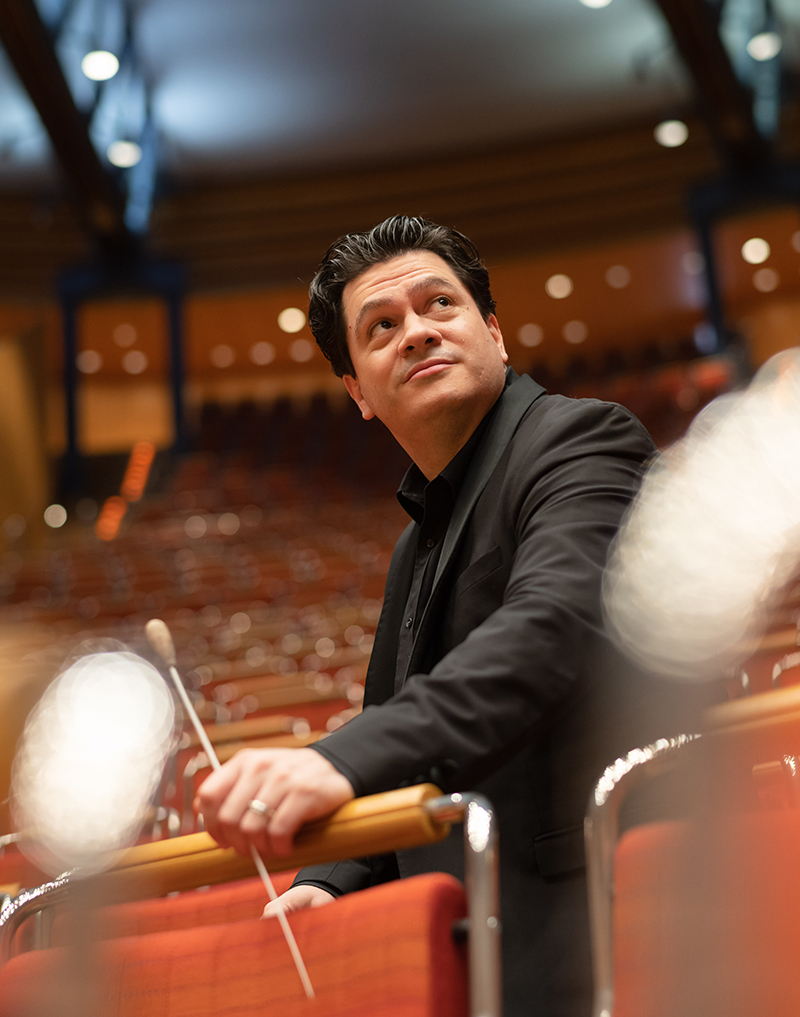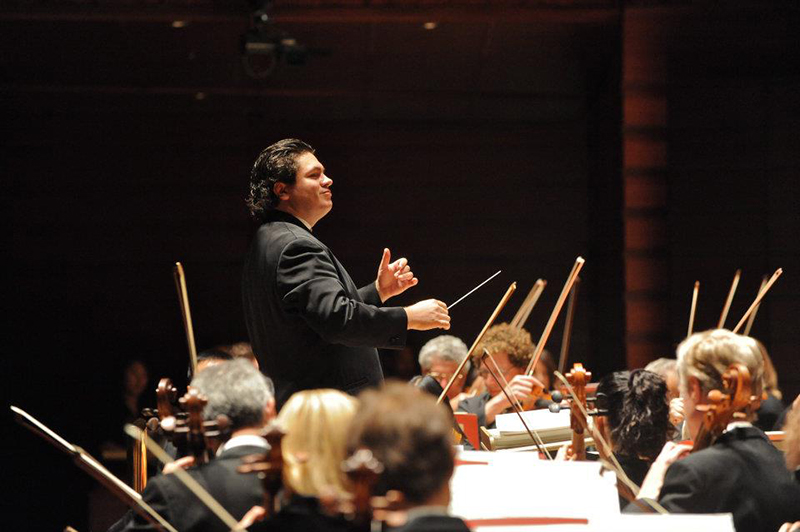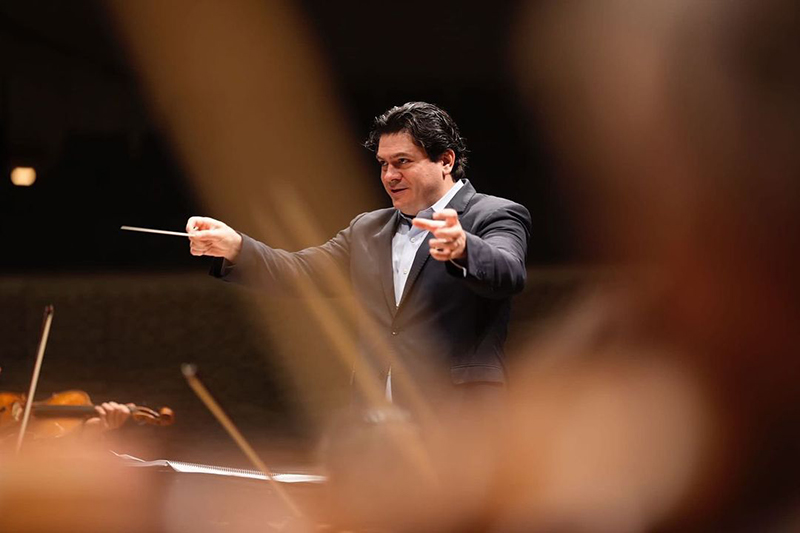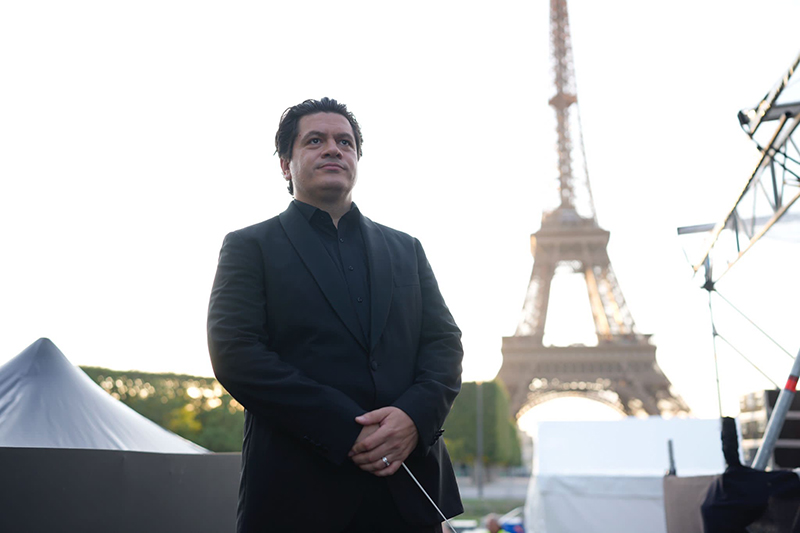Getting to Know Cristian Măcelaru, Part II
Music Director Designate Cristian Măcelaru will be introduced to CSO audiences in a series of articles in Fanfare Magazine. Follow along as the story of the CSO’s 14th Music Director unfolds.
by James M. Keller

Cristian Mӑcelaru inside the Kölner Philharmonie in Cologne as Chief Conductor of the WDR Sinfonieorchester. Credit: Peter Adamik
Readers of the November/December edition of Fanfare Magazine learned about the early years of Cristian (“Cristi”) Măcelaru, the Music Director Designate of the Cincinnati Symphony Orchestra—his upbringing in Romania and the lucky breaks that led to his growth as a violinist and conductor at Interlochen Arts Academy in Michigan, the University of Miami in Florida and Rice University in Texas. (Read Part 1 at cincinnatisymphony.org/CristianMacelaru.)
Through his work as a concertmaster and his early experiences on the podium he absorbed the subtleties of how an orchestra makes magic. He came within range of the big-time spotlight when he was appointed assistant conductor of The Philadelphia Orchestra in 2011 and then was promoted to associate conductor the next year and to conductor-in-residence from 2014 to 2016.
Concertgoers naturally focus on an orchestra’s music director and the guest conductors who lead subscription concerts week after week. Less visible, under normal circumstances, are the journeyman conductors who labor behind the scenes, but they play an important role in the smooth functioning of an ensemble. “An assistant conductor,” says Cristi, “can end up working more in the organization than even the music director, because the assistant conductor is always on call week after week, always ready to step in, always ready to give meaningful feedback. Those are make-or-break times for a young conductor, when you get the call and someone says, ‘Hey, how’s your Petrouchka? You’re going on in two hours.’ You have to really know the music.”
His relationship with The Philadelphia Orchestra began even before he received his official appointment, when the orchestra invited him to cover a program being led by its chief conductor, Charles Dutoit. It included Richard Strauss’ tone poem Don Juan, a touchstone of orchestral virtuosity; in fact, most of the string players in any top-tier orchestra probably played its opening page at their audition.
“I remember sitting down and hearing The Philadelphia Orchestra begin to play Don Juan and thinking to myself, ‘Oh, my God, this is perfect,’” he says. “What would be the process of taking a Philadelphia Orchestra from the first rehearsal to the concert? And let me tell you, The Philadelphia Orchestra, like the Cincinnati Symphony Orchestra, like most major American orchestras, they do not sound bad on day one. It’s already pretty close to a really beautiful performance. So then what does a conductor do to create an interpretation that has their own stamp, their own identity? I saw this as an unbelievable opportunity to have real-life training lessons.”
As the assistant conductor, he anticipated being one of several conductors watching from the wings. The Philadelphia Orchestra traditionally had an assistant conductor and an associate conductor on staff, and also a couple of conductors-in-training from the League of American Orchestras, plus extra conductors who might assist on specific projects. The place offered conducting stimulation at every turn. The position of assistant conductor was, for Cristi, a dream come true. But then…

Cristian Măcelaru as The Philadelphia Orchestra’s Assistant Conductor. Credit: Pete Checchia
“The morning after I got offered the job, they filed for bankruptcy.” It sent shock waves through the music world, and it took more than a year for the orchestra to get back on a sustainable track. “Really, it was a traumatic experience for them,” he says. “But for me, as the assistant conductor, it led to a unique circumstance. They cut every position that was not absolutely essential—no associate conductor, no conducting fellows. So I was literally the only conductor on staff. In that first season as assistant conductor, I conducted 20 programs, which was unheard of. Any assistant conductor would be glad to do two or three. It was as if someone was paying for my room and board to study at the greatest private training academy.”
Not for the first time in his life, Cristi had found himself at the right place at the right time.
“In my experience,” he says, “musicians are excited to be able to call their friends at other orchestras and say, ‘We just had a concert last night with this young conductor who did a great job.’ That’s how careers are made.” As word circulated, offers started to arrive—debuts with the Chicago Symphony, the New York Philharmonic, major orchestras in Europe. He didn’t have to negotiate this alone. When he began at The Philadelphia Orchestra, he also signed on with a professional manager, Charlotte Lee, who still represents him to this day. “The relationship between a conductor and a manager is something like that between a conductor and a soloist in a concert. People ask me, ‘Who is leading, you or the soloist?…and the answer is ‘Yes.’”
His calendar started to fill up, and when The Philadelphia Orchestra elevated him to conductor-in-residence, it arranged things so he could accept more engagements elsewhere. Cancellations are also a godsend to rising conductors, at least to those who have a vast repertoire of pieces that can be moved to the front burner at a moment’s notice. “I hadn’t conducted everything that was likely to come up on an orchestral program, but I had studied all of it and really could conduct it if I was called on,” says Cristi. “This allowed my manager Charlotte to seize many opportunities for me. But I didn’t just sit on the couch expecting her to do it all. I made contacts, too, and then directed them to her to work out the details.”
One thing led to another. The first time he appeared with the DSO Berlin (German Symphony Orchestra Berlin), the executive director of the WDR Sinfonieorchester (Cologne) happened to be in the audience. Jukka-Pekka Saraste had just stepped down as Cologne’s conductor. “They invited me to conduct a week—Stravinsky’s Rite of Spring and a two-piano concerto by Avner Dorman. I did it and returned home to Philadelphia, where I had just sat down to dinner when the phone rang. Alan Gilbert had cancelled in Cologne. Could I substitute? I was in Philadelphia for exactly four hours before I returned and conducted Tchaikovsky’s Fourth and Mozart’s D minor Piano Concerto with Rudolf Buchbinder, and at the end of the week they offered me the position of chief conductor—so we moved to Europe.” At the end of the 2024–25 season, he will relinquish that podium, just in time to pivot to Cincinnati.

Cristian Măcelaru leading the Orchestre National de France on tour at the Elbphilharmonie in Hamburg, Germany. Credit: Orchestre National de France
Something similar happened in Paris: his debut there stirred up enough excitement for the Orchestre National de France (ONF) to schedule him for guest appearances in 2018 and 2019. In November 2019, it announced that he would be their next music director, beginning with the 2021–22 season. But when the orchestra’s music director, Emmanuel Krivine, resigned unexpectedly, he consented to start a year early, and now he’s under contract through 2026–27.
You may be thinking that things have an uncanny way of falling into place for Cristi, that he is the sort of guy you ought to take along when you buy a lottery ticket. You would not be wrong, but it is also true that opportunities tend to arise for people who are prepared to make good on them.
Being a music director, he finds, is very different from being a guest conductor. As a guest conductor, he strives to wipe away preconceptions about how a piece must be played, erase assumptions that have accumulated, and build an interpretation that honors the details of what the composer actually wrote in the score. A music director, on the other hand, can address the ongoing attributes of an ensemble.
He set different goals with his orchestras in Cologne and Paris. “In Cologne,” he explains, “I somewhat changed the sound concept. It’s an extremely flexible orchestra, with an incredible palette of colors and dynamics, especially at soft volumes. It was a very good orchestra when I began, and I feel it is a truly extraordinary one now. In Paris, we focused on consistency and on balance, on the sense of playing together in a profound way, with the musicians listening to each other intently. Now they play as if these things were never an issue.”
Cristi arrives in Cincinnati with a lot of experience under his belt, enough to have developed a philosophy of conducting that he shares when teaching the next generation. It consists of seven “action steps”: Discover, Familiarize, Comprehend, Absorb, Retain, Develop and Give.
He elaborates: “Discover refers to constant curiosity, to searching for the next thing. Familiarize is just to have a first pass at things. After you discover something, you familiarize and decide whether you want to go further. Then Comprehend, to really understand the music—you spend a lot of time on this plateau. Absorb is to allow it, through time and repetition, to become part of your psyche, part of your outlook. Then Retain—this is the step where I tell my students they must do whatever is necessary to memorize a piece, to try to put it in their minds so they don’t have to think about it anymore. Develop is where you have a bit of fun by bringing, only at this point, your own take on things, your own interpretation, which has to do with fluctuations of tempo and intensity, finding subtle things that you can add to the piece without changing what the composer has written. That is a lifelong process that develops. And Give is the necessity of all art to be shared, so that it actually becomes art, so it is not just in our heads or something selfishly kept, but rather something that connects people through the sharing.”

Cristian Măcelaru, Orchestre National de France Concert de Paris. Credit: Christophe Abramowitz
James M. Keller, in his 25th season as program annotator of the San Francisco Symphony, was formerly program annotator of the New York Philharmonic and is the author of Chamber Music: A Listener’s Guide (Oxford University Press).